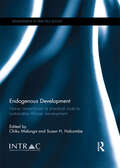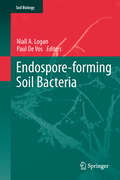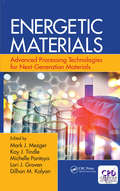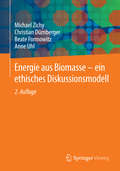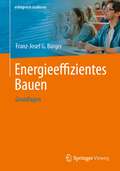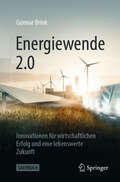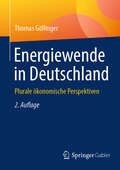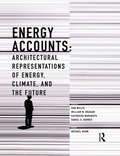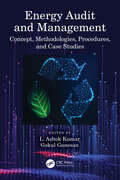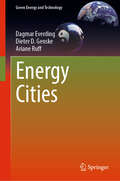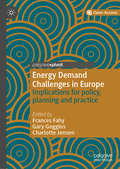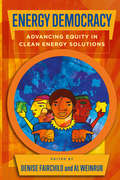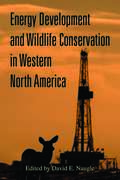- Table View
- List View
Endlessly Green
by Savita HiremathEndlessly Green looks at the history, the science and the art of composting and sustainable waste management through a kaleidoscope of philosophical, moral and ethical intricacies. The author digs into her rich pool of experiential learnings and raw inputs gathered through a decade of research, legwork and fearless execution. This engaging field guide equips community volunteers, activists, students, SWM practitioners and professionals with practical inputs on segregation, composting and organic gardening/farming, making sustainability imaginable in a concrete jungle. In doing so, it helps individuals discover the possibilities of bringing about a change in their environment by engaging their own environmental sensibilities. Endlessly Green is an extraordinary celebration of things small and significant and the fight against waste, culminating in a replicable and scalable end-to-end solution.
Endogenous Development: Naïve Romanticism or Practical Route to Sustainable African Development (Development in Practice Books)
by Chiku Malunga and Susan H. HolcombeWestern ideas, worldviews, actors, tools, models, and frameworks have long dominated development theory and practice in Africa. The resulting development interventions are too rarely locally rooted, locally driven, or resonant with local context. At the same time, theories and practices from developing countries rarely travel to the Western agencies dominating development, undermining the possibility of a beneficial synergy that could be obtained from the best of both worlds. There are many reasons why the experiences of locally driven development are not communicated back to global development actors, including, but not limited to, the marginal role of Southern voices in global forums. This volume gives a platform to authentic African voices and non-African collaborators, to explore what endogenous development means, how it can be implemented, and how an endogenous development approach can shape local, national and global policies. This book was originally published as a special issue of Development in Practice.
Endospore-forming Soil Bacteria
by Paul De Vos Niall A. LoganAerobic endospore-forming bacteria are found in soils of all kinds, ranging from acid to alkaline, hot to cold, and fertile to desert. It is well known that endospores confer special properties upon their owners and play dominant parts in their life cycles and dispersal, and much has been written about the spores, genetics, and economic importance of these organisms. Much has also been written about soil ecology, but there is a relative dearth of literature that brings together different aspects of the behaviour and characters of endospore-formers with their contributions to soil ecosystems. This Soil Biology volume fills that gap. Following chapters that describe the current classification of these organisms, that review methods for their detection and for studying their life cycles in soils, and that examine their dispersal, other chapters show that they are active and dynamic members of soil floras that interact widely with other soil inhabitants, with roles in nitrogen fixation, denitrification, and soil remediation.
Ends of the Earth: Journeys to the Polar Regions in Search of Life, the Cosmos, and our Future
by Neil ShubinFrigid, remote and inhospitable – the polar regions seem far removed from our everyday lives. But these seemingly isolated ice realms shape life on our planet far more than we realise, influencing everything from the climate to ocean health. They may even hold the secrets to the origins of the Earth. Taking an epic journey of discovery from pole-to-pole, ferrying between penguins and polar bears, Ends of the Earth reveals the polar regions as never before. Meeting with the leading physicists, climatologists, geologists, biologists and palaeontologists working in these extremes – often as eccentric as they are intrepid – Neil Shubin presents the compelling new science of the Arctic and Antarctic with characteristic verve and expertise.
Enduring Acequias: Wisdom of the Land, Knowledge of the Water (Querencias Series)
by Juan Estevan ArellanoFor generations the Río Embudo watershed in northern New Mexico has been the home of Juan Estevan Arellano and his ancestors. From this unique perspective Arellano explores the ways people use water in dry places around the world. Touching on the Middle East, Europe, Mexico, and South America before circling back to New Mexico, Arellano makes a case for preserving the acequia irrigation system and calls for a future that respects the ecological limitations of the land.
Energetic Materials: Advanced Processing Technologies for Next-Generation Materials
by Mark J. Mezger Kay J. Tindle Michelle Pantoya Lori J. Groven Dilhan KalyonThis book will take an in-depth look at the technologies, processes, and capabilities to develop and produce "next generation" energetic materials for both commercial and defense applications, including military, mining operations, oil production and well perforation, and construction demolition. It will serve to highlight the critical technologies, latest developments, and the current capability gaps that serve as barriers to military fielding or transition to the commercial marketplace. It will also explain how the processing technologies can be spun out for use in other non-energetics related industries.
Energetics of the Climate System (ISTE Invoiced)
by Herve Le Treut Mounia MostefaouiEnergetics of the Climate System is derived from a course taught by Hervé Le Treut, who has been delivering this lecture series for decades to students at institutions such as the École Normale Supérieure, École Polytechnique, and Sorbonne University, along with students from other international institutions. This book offers a comprehensive understanding of the intricate energetics driving the Earth’s climate system. The goal was not only to capture the depth and complexity of this subject, but also to preserve the pedagogical brilliance and unique storytelling style of Hervé Le Treut. This work stands as both a tribute to his remarkable contributions and a reflection of his passion for teaching, having mentored generations of climatologists, engineers, and economists, many of whom – including the co-author Mounia Mostefaoui – have greatly benefited from his guidance. The text retains elements of an oral presentation to evoke the professor’s distinctive voice and teaching approach. The book is structured into five chapters, each independent and deeply interconnected, and is complemented by an appendix of exercises to reinforce its material.
Energie aus Biomasse - ein ethisches Diskussionsmodell
by Michael Zichy Christian Dürnberger Beate Formowitz Anne UhlEnergie aus Biomasse wird auf politischer, wissenschaftlicher und gesellschaftlicher Ebene höchst kontrovers diskutiert. – Dieses Buch liefert eine fundierte, klare und gut verständliche Analyse und Diskussion der ethischen und kulturell-emotionalen Aspekte von Energie aus Biomasse. Es diskutiert die Frage der Verantwortung und bringt naturwissenschaftliche und ethische Expertise in einen fruchtbaren Dialog. Vergleichende Fallstudien und Szenarien sorgen für die praktische Anbindung an die derzeitige landwirtschaftliche Praxis. Die zweite, überarbeitete Auflage bezieht sich auf die aktuellen gesetzlichen Rahmenbedingungen und berücksichtig die neuesten wissenschaftlichen Beiträge zum Diskurs, wie zum Beispiel zu indirekten Landnutzungsänderungen.
Energieeffizientes Bauen: Grundlagen (erfolgreich studieren)
by Franz-Josef G. BürgerDer Arbeitsbereich des „Energieeffizienten Bauens“ bietet eine gute Zukunftsperspektive. Die fachliche Auseinandersetzung mit dem Thema „Energieeffizientes Bauen“ erfordert interdisziplinäres Arbeiten. Architekten und Bauingenieure werden bei der Planung und Ausführung der gebäudetechnischen Einrichtungen zunehmend mit den Aufgabenstellungen des Maschinenbaus und der Elektrotechnik konfrontiert. Die Buchinhalte beschreiben die naturwissenschaftlichen Grundlagen für die richtige Wahl der Baumaterialien und Baukonstruktionen im Hinblick auf Energieeffizienz, Nachhaltigkeit und Methoden zur Wirtschaftlichkeitsbetrachtung. Aufgaben am Ende der Kapitel ermöglichen die Selbstkontrolle und Festigung des angeeigneten Wissens.
Energiemanagement nach ISO 50001: Energieeffizientes Management (essentials)
by Manfred SietzEnergieeffizientes Handeln eines Unternehmens wird weltweit einheitlich und zertifizierbar durch die Norm ISO 50001 beschrieben. Sie schafft einen einheitlichen Rahmen, um die Energieeffizienzleistung von Unternehmen zu verbessern und vergleichbar zu machen.
Energiestädte
by Dieter D. Genske Dagmar Everding Ariane RuffMit der Loslösung der Städte und Regionen von fossil-nuklearen Energiequellen gewinnt der energetisch-ökologische Stadtumbau zunehmend an Bedeutung. Eine wachsende Zahl von Akteuren engagiert sich für die Umstellung der Energieversorgung auf erneuerbare Energien sowie für ressourcenschonende ökologische Kreisläufe in ihrem Lebensumfeld. Der energetisch-ökologische Stadtumbau verbessert die Lebens- und Umweltverhältnisse in den Stadtteilen unmittelbar, eröffnet neue Chancen der Wertschöpfung und schafft Arbeitsplätze. Städte werden zu Energiestädten umgebaut, die den Leitmotiven der Nachhaltigkeit, der Minimierung energetisch-ökologischer Fußabdrücke und der Reduzierung des Flächenverbrauchs folgen.Das Buch entwirft Zukunftsbilder des Stadtumbaus für den Diskurs der Akteure. Es werden stadtplanerische, ingenieurtechnische und ökonomische Handlungsfelder des energetisch-ökologischen Stadtumbaus einschließlich ihrer methodischen Lösungswege disziplin-übergreifend beschrieben. Zu dieser Darstellung gehört auch die Verdeutlichung anhand einer Vielzahl interessanter Projektbeispiele.Zielgruppe dieses Buches sind insbesondere Kommunalverwaltungen und Klimaschutzmanager, Planungs- und Ingenieurbüros, Umweltorganisationen sowie Studierende und Lehrende.
Energiewende 2.0: Innovationen für wirtschaftlichen Erfolg und eine lebenswerte Zukunft
by Gunnar BrinkDas Buch Energiewende 2.0 zeigt einen lösungsorientierten Ansatz zur Bewältigung des Klimawandels. In den einzelnen Kapiteln untersucht der Autor den technologischen Status unterschiedlicher Arten erneuerbarer Energien, indem er jede Technologie einzeln betrachtet, von Solarenergie über Windkraft bis hin zu innovativen Ansätzen wie Wellen- und Gezeitenenergie. Dabei werden nicht nur das technische Potenzial und die technologische Reife erläutert, sondern auch die wirtschaftlichen, politischen und sozialen Aspekte, die den Erfolg oder Misserfolg dieser Technologien beeinflussen könnten. Um radikale Innovationen aus dem Labor auf den globalen Energiemarkt zu bringen, braucht es ein unterstützendes Ökosystem: Innovation muss mit der entsprechenden technologischen Entwicklung, der Bereitschaft des Marktes, disruptive Technologien zu übernehmen, den lokalen Kapazitäten zur Umsetzung neuer Energieprojekte, einer Energiepolitik mit Klimazielen sowie ausreichendem und adäquaten Investitionskapital einhergehen. Technologieentwickler, Start-ups sowie etablierte Unternehmen müssen flexibel, anpassungsfähig und offen für neue Ideen sein sowie sich auf neue Technologien, Geschäftsmodelle und Strategien einlassen. Mit einem Blick in die Zukunft erkundet der Autor mögliche Wege, wie wir die nächste Generation von Energielösungen effektiv einsetzen und gestalten können, um wirtschaftliche Vorteile zu erzielen und gleichzeitig eine lebenswerte und nachhaltigere Welt für alle zu schaffen.
Energiewende in Deutschland: Plurale ökonomische Perspektiven
by Thomas GöllingerDie Energiewende ist ein Transformationsprozess, der Herausforderungen in unterschiedlichen Themengebieten mit sich bringt, und deshalb ganzheitlich betrachtet werden muss. Dieses Buch bietet einen Einstieg in die komplexe Thematik, indem es die Energiewende in Deutschland aus unterschiedlichen Blickwinkeln, vor allem aus traditioneller industrie- und institutionenökonomischer sowie evolutorisch-systemischer Sicht, kompakt darstellt sowie die vielfältigen Herausforderungen und potenzielle Lösungen aufzeigt. Neben den Ursprüngen der deutschen Energiewende betrachtet es dazu auch die aktuelle Phase mit der Wärmewende und der Sektorkopplung im Mittelpunkt und gibt einen Ausblick auf die nächsten Phasen. Zudem diskutiert es eine mögliche deutsche Vorreiterrolle bei der notwendigen globalen Energiewende. Für die 2. Auflage wurden alle Inhalte umfassend aktualisiert und überarbeitet sowie neue politische Entwicklungen auf nationaler, europäischer und geopolitischer Ebene - insbesondere der Russland-Ukraine-Konflikt und die „Rush-to-burn&“-Problematik - berücksichtigt.
Energiewirtschaft 2014: Fakten und Chancen der Tiefen Geothermie (essentials)
by Willi Freeden Mathias Bauer Hans Jacobi Thomas NeuDie durch das Reaktorunglück in Fukushima forcierte Energiewende hin zu einer Stromversorgung mit primär erneuerbaren Energien konzentriert sich in der aktuellen Wahrnehmung nur auf den Ausbau von Solar und Windkraftenergie. Dabei wird vergessen, dass aufgrund fehlender Stromspeichertechnologien und Überlandstromtrassen eine erneuerbare Energie benötigt wird, die konstant Strom liefern und so Erzeugungsschwankungen bei Solar- und Windkraftenergie ausgleichen kann. Tiefe Geothermie, also Energie, die aus der Erde kommt, kann diese Aufgabe leisten, da sie die einzige erneuerbare Energie ist, die nicht klimatischen oder wetterbedingten Schwankungen unterliegt. Mit einem durch Wissenschaftlern und Praktikern erstellten Normenkatalog für tiefengeothermische Bohrungen, würde hier ein höchstmöglichen Sicherheitsstandard erreicht, und die wirtschaftlichen wie geologischen Risiken jedes Projektes minimiert werden.
Energy & Ethics
by Benjamin K. SovacoolBenjamin K. Sovacool applies concepts from justice and ethics theory to contemporary energy problems, and illustrates particular solutions to those problems with examples and case studies from around the world.
Energy (Let's Explore Science)
by Tim CliffordExplores energy, how we use it, different yypes and forms, conservation and transformation of energy, renewable vs. non-renewable, and energy conservation.
Energy Accounts: Architectural Representations of Energy, Climate, and the Future
by Michael MannHow does one tell the story of energy production, use, or conservation in a manner sufficiently convincing to influence policy, behavior, and design? Energy Accounts explores potential answers to this question through compelling images, data visualizations, narratives, and other examples of accounting for energy. Organized into a collection containing both examples of best practices and critiques, this impressive array of projects and contributors combines text and graphic material to explore different representations of energy data. Including work from Kieran Timberlake, SHoP, AMO, Lateral Office, WOHA, and many more, the book boasts a unique graphic design which supports and enhances its role as a valuable resource for professionals and students in architecture, engineering, and urban design.
Energy Analysis for a Sustainable Future: Multi-Scale Integrated Analysis of Societal and Ecosystem Metabolism
by Mario Giampietro Kozo Mayumi Alevgül H. ŞormanThe vast majority of the countries of the world are now facing an imminent energy crisis, particularly the USA, China, India, Japan and EU countries, but also developing countries having to boost their economic growth precisely when more powerful economies will prevent them from using the limited supply of fossil energy. Despite this crisis, current protocols of energy accounting have been developed for dealing with fossil energy exclusively and are therefore not useful for the analysis of alternative energy sources. The first part of the book illustrates the weakness of existing analyses of energy problems: the science of energy was born and developed neglecting the issue of scale. The authors argue that it is necessary to adopt more complex protocols of accounting and analysis in order to generate robust energy scenarios and effective assessments of the quality of alternative energy sources. The second part of the book introduces the concept of energetic metabolism of modern societies and uses empirical results. The authors present an innovative approach – Multi-Scale Integrated Analysis of Societal and Ecosystem Metabolism (MuSIASEM) – capable of characterizing the quality of alternative energy sources in relation to both environmental constraints and socio-economic requirements. This method allows the metabolic pattern of a society to be described in relation to its feasibility, when looking at biophysical factors, and desirability, when looking at socio-economic factors.Addressing the issue of scale in energy analysis by cutting through the confusion found in current applications of energy analysis, this book should be of interest to researchers, students and policy makers in energy within a variety of disciplines.
Energy Audit and Management: Concept, Methodologies, Procedures, and Case Studies
by L. Ashok Kumar Gokul GanesanThis book describes the energy management concepts, energy audit principles, resource efficiency, and other energy conservation opportunities involved in different sectors across varied industries. Real-time case studies from various large industrial sectors, like cement, paper and pulp, refineries, manufacturing, garments and textile processing, power plants, and other MSME industrial sectors with cross functional energy conservation opportunities, are included. It also describes the future scope of energy auditing and management including IoT and data analytics. It also helps to gather the energy generated and utilization, energy conservation, and other process related data. Features: Provides entire coverage of energy management and audit concepts. Explores energy audit methodologies and energy saving initiatives. Incorporates current technologies like machine learning, IoT, data analytics in energy audit for reliability improvement. Includes case studies covering detailed energy saving calculation with investment pay back calculations. This book is aimed at researchers, professionals, and graduate students in electrical engineering, power systems, energy systems, and renewable energy.
Energy Cities (Green Energy and Technology)
by Dieter D. Genske Dagmar Everding Ariane RuffWith cities and regions moving away from fossil-nuclear energy sources, the importance of energy-ecological urban transformation is growing. A growing number of stakeholders are committed to transitioning energy supplies to renewable sources and promoting resource-efficient ecological cycles in their communities. Energy-ecological urban transformation directly improves living and environmental conditions in neighborhoods, creates new economic opportunities, and generates jobs. Cities are being transformed into 'energy cities' that adhere to the principles of sustainability, minimizing energy-ecological footprints, and reducing land consumption. This book envisions future scenarios of urban transformation for stakeholder discourse. It provides a cross-disciplinary description of urban planning, engineering, and economic approaches to energy-ecological urban transformation, including methodological solutions. Numerous interesting project examples are presented to illustrate these concepts. The target audience for this book includes municipal administrations and climate protection managers, planning and engineering firms, environmental organizations, as well as students and educators.
Energy Cooperation in South Asia: Utilizing Natural Resources for Peace and Sustainable Development (Routledge Explorations in Energy Studies)
by Mirza Sadaqat HudaThis book analyses the key political challenges to regional energy cooperation in South Asia. It argues that investment in the planning of regional energy projects can increase their viability and also drive integration and peacebuilding. Regional cooperation has been substantiated by academics and multilateral development banks as one of the most viable solutions to South Asia’s crippling energy crisis. However, three decades of national and regional efforts have failed to develop a single multilateral energy project or foster high levels of bilateral cooperation. Using data collected through extensive interviews with policymakers in India, Bangladesh, Pakistan and Nepal, this book identifies the specific roadblocks to energy cooperation – including domestic politics and the failure of leadership on multiple levels - and evaluates how these political challenges determine regional interactions on energy securitisation, environmental cooperation and human rights. Huda then undertakes case studies on four transnational energy projects to highlight specific policy recommendations to overcome these challenges, suggesting planning mechanisms through which the significant issue of energy cooperation in South Asia can be addressed. This book will be of great interest to students and scholars of energy security and geopolitics, natural resource governance and South Asian politics.
Energy Demand Challenges in Europe: Implications for policy, planning and practice
by Frances Fahy Gary Goggins Charlotte JensenThis open access book examines the role of citizens in sustainable energy transitions across Europe. It explores energy problem framing, policy approaches and practical responses to the challenge of securing clean, affordable and sustainable energy for all citizens, focusing on households as the main unit of analysis. The book revolves around ten contributions that each summarise national trends, socio-material characteristics, and policy responses to contemporary energy issues affecting householders in different countries, and provides good practice examples for designing and implementing sustainable energy initiatives. Prominent concerns include reducing carbon emissions, energy poverty, sustainable consumption, governance, practices, innovations and sustainable lifestyles. The opening and closing contributions consider European level energy policy, dominant and alternative problem framings and similarities and differences between European countries in relation to reducing household energy use. Overall, the book is a valuable resource for researchers, policy-makers, practitioners and others interested in sustainable energy perspectives.
Energy Democracy: Advancing Equity in Clean Energy Solutions
by Denise Fairchild Al Weinrub Diego Angarita Horowitz Isaac Baker Lynn Benander Strela Cervas Ben Delman Anthony Giancatarino Vivian Yi Huang Derrick Johnson Cecilia Martinez Michelle Mascarenhas-Swan Anya Schoolman Dr Sean Sweeney Maggie Tishman Miya YoshitaniThe near-unanimous consensus among climate scientists is that the massive burning of gas, oil, and coal is havingcataclysmic impacts on our atmosphere and climate. These climate and environmental impacts are particularly magnifiedand debilitating for low-income communities and communities of color.Energy democracy tenders a response and joins the environmental and climate movement with broader movements for social and economic change in this country and around the world.Energy Democracy brings together racial, cultural, and generational perspectives to show what an alternative, democratized energy future can look like. The book will inspire others to take up the struggle to build the energy democracy movement.
Energy Development and Wildlife Conservation in Western North America
by David E. NaugleEnergy Development and Wildlife Conservation in Western North America offers a road map for securing our energy future while safeguarding our wildlife heritage. Contributors show how science can help craft solutions to conflicts between wildlife and energy development by delineating core areas, identifying landscapes that support viable populations, and forecasting future development scenarios to aid in conservation design. The book calls for a shift away from site-level management that has failed to mitigate cumulative impacts on wildlife populations toward broad-scale planning and implementation of conservation in priority landscapes. It concludes by identifying ways that decision makers can remove roadblocks to conservation, and provides a blueprint for implementing conservation plans.
Energy Dynamics and Climate Mitigation: An Indian Perspective (Advances in Geographical and Environmental Sciences)
by Asheem SrivastavThis book analyzes the current approaches to energy management in India that is based on a carbon-intensive pathway, which if continued, may have serious implications for climate change mitigation with severe consequences for human health and survival. India, being a signatory to the United Nations Framework Convention on Climate Change (UNFCCC), the Kyoto Protocol, and the Paris Agreement, is committed to reducing greenhouse gas emissions; however, the country’s dilemmas are whether to prioritize environment over economy or vice versa and also whether economic growth can be sustained by relying on carbon-intensive development. Those are explored in this book. The Indian economy is poised for a big leap in the near future, and the topmost priority of the government is to ensure energy security, accessibility, and affordability for nearly 1.5 billion people. Currently, 70% of India’s electricity generation comes from coal- and oil-based thermal power plants, and only 12–15% of energy is generated from renewable sources. Experts are of the view that the demand for coal and gas power generation will continue to rise and is expected to reach the equivalent of nearly 2 billion t of oil by 2030. The annual consumption of natural gas is expected to increase fourfold to 200 billion m3 a year in the near future, and its share in the primary energy basket of coal, oil, and gas will rise from 6.5% to 15% by 2030. This will not only cause a significant drain on foreign reserves but will also pose an enormous challenge to policymakers and scientists. This book serves as a useful guide in shaping India’s future energy policy.

